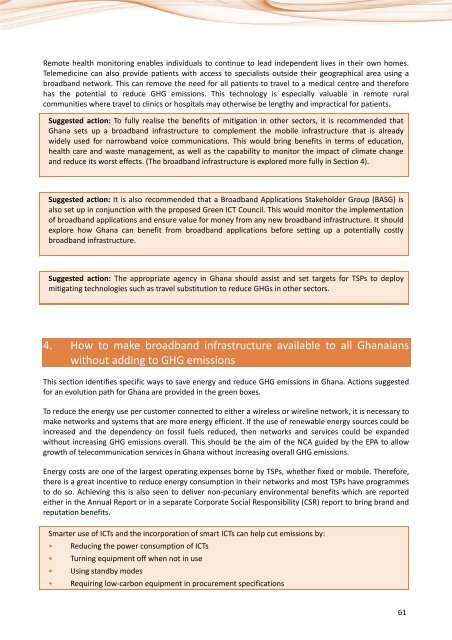Information and communication technologies (ICTs) and ... - ITU
Information and communication technologies (ICTs) and ... - ITU
Information and communication technologies (ICTs) and ... - ITU
You also want an ePaper? Increase the reach of your titles
YUMPU automatically turns print PDFs into web optimized ePapers that Google loves.
Remote health monitoring enables individuals to continue to lead independent lives in their own homes.<br />
Telemedicine can also provide patients with access to specialists outside their geographical area using a<br />
broadb<strong>and</strong> network. This can remove the need for all patients to travel to a medical centre <strong>and</strong> therefore<br />
has the potential to reduce GHG emissions. This technology is especially valuable in remote rural<br />
communities where travel to clinics or hospitals may otherwise be lengthy <strong>and</strong> impractical for patients.<br />
Suggested action: To fully realise the benefits of mitigation in other sectors, it is recommended that<br />
Ghana sets up a broadb<strong>and</strong> infrastructure to complement the mobile infrastructure that is already<br />
widely used for narrowb<strong>and</strong> voice <strong>communication</strong>s. This would bring benefits in terms of education,<br />
health care <strong>and</strong> waste management, as well as the capability to monitor the impact of climate change<br />
<strong>and</strong> reduce its worst effects. (The broadb<strong>and</strong> infrastructure is explored more fully in Section 4).<br />
Suggested action: It is also recommended that a Broadb<strong>and</strong> Applications Stakeholder Group (BASG) is<br />
also set up in conjunction with the proposed Green ICT Council. This would monitor the implementation<br />
of broadb<strong>and</strong> applications <strong>and</strong> ensure value for money from any new broadb<strong>and</strong> infrastructure. It should<br />
explore how Ghana can benefit from broadb<strong>and</strong> applications before setting up a potentially costly<br />
broadb<strong>and</strong> infrastructure.<br />
Suggested action: The appropriate agency in Ghana should assist <strong>and</strong> set targets for TSPs to deploy<br />
mitigating <strong>technologies</strong> such as travel substitution to reduce GHGs in other sectors.<br />
4. How to make broadb<strong>and</strong> infrastructure available to all Ghanaians<br />
without adding to GHG emissions<br />
This section identifies specific ways to save energy <strong>and</strong> reduce GHG emissions in Ghana. Actions suggested<br />
for an evolution path for Ghana are provided in the green boxes.<br />
To reduce the energy use per customer connected to either a wireless or wireline network, it is necessary to<br />
make networks <strong>and</strong> systems that are more energy efficient. If the use of renewable energy sources could be<br />
increased <strong>and</strong> the dependency on fossil fuels reduced, then networks <strong>and</strong> services could be exp<strong>and</strong>ed<br />
without increasing GHG emissions overall. This should be the aim of the NCA guided by the EPA to allow<br />
growth of tele<strong>communication</strong> services in Ghana without increasing overall GHG emissions.<br />
Energy costs are one of the largest operating expenses borne by TSPs, whether fixed or mobile. Therefore,<br />
there is a great incentive to reduce energy consumption in their networks <strong>and</strong> most TSPs have programmes<br />
to do so. Achieving this is also seen to deliver non-pecuniary environmental benefits which are reported<br />
either in the Annual Report or in a separate Corporate Social Responsibility (CSR) report to bring br<strong>and</strong> <strong>and</strong><br />
reputation benefits.<br />
Smarter use of <strong>ICTs</strong> <strong>and</strong> the incorporation of smart <strong>ICTs</strong> can help cut emissions by:<br />
• Reducing the power consumption of <strong>ICTs</strong><br />
• Turning equipment off when not in use<br />
• Using st<strong>and</strong>by modes<br />
• Requiring low-carbon equipment in procurement specifications<br />
61

















